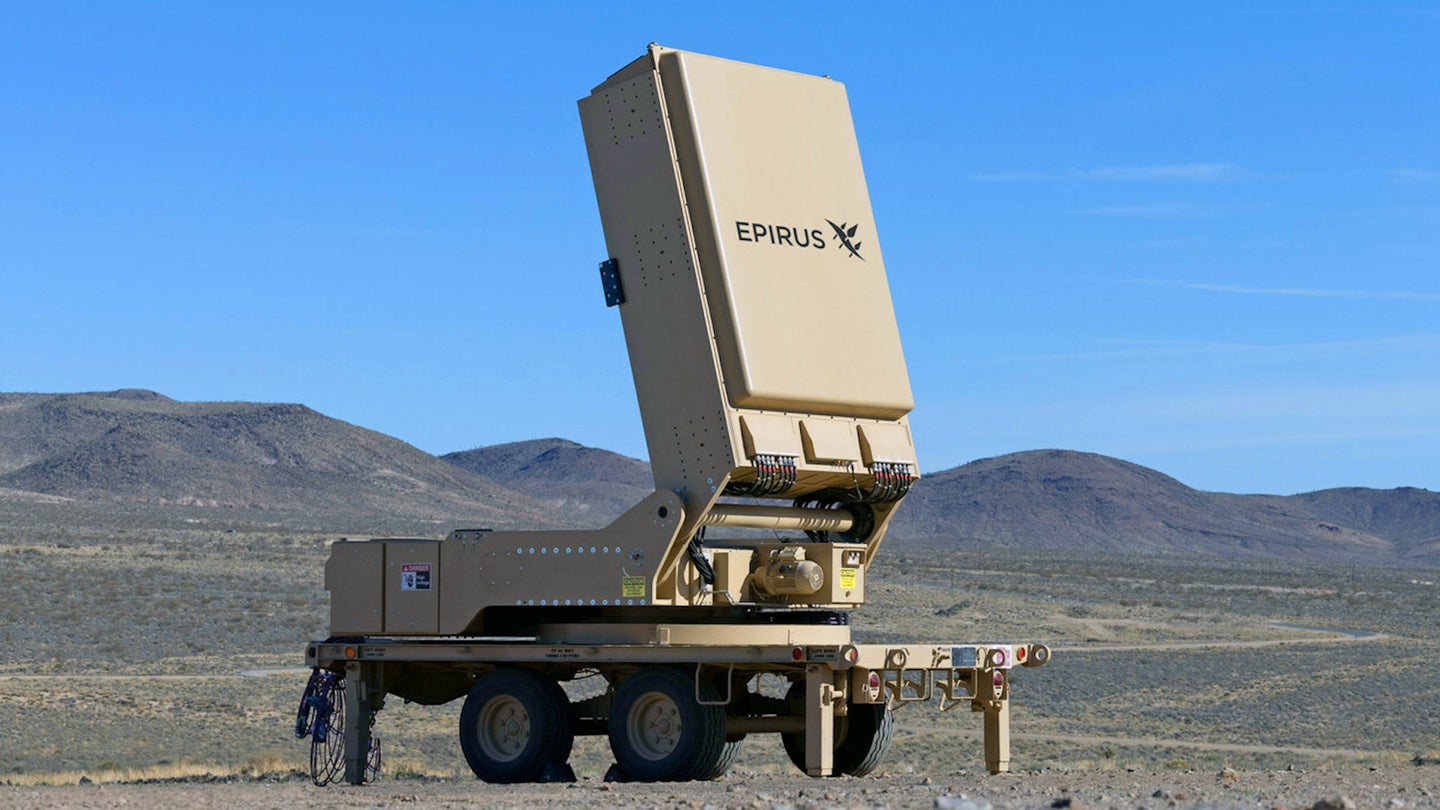The Army is readying a new directed energy weapon to swat drone swarms out of the sky
The Army is moving forward with a new microwave weapon to help provide air defense against incoming enemy drone swarms.

The Army is moving forward with a new directed energy weapon to help provide air defense against swarms of incoming enemy drones.
Defense contractor Epirus, Inc. announced on Monday that it had received a $66.1 million contract from the Army’s Rapid Capabilities and Critical Technologies Office (RCCTO) to develop prototypes of its Leonidas high-powered microwave short-range air defense system.
Epirus will “rapidly deliver several prototype systems” to the Army this year “with options to acquire additional support services” as part of the service’s Indirect Fire Protection Capability-High-Power Microwave Program (IFPC-HPM), the company said in a statement.
The IFPC-HPM system is intended to provide a ground-based direct-energy weapon that can “acquire, track, engage, and defeat” all manner of incoming threats, from cruise missiles and rocket, artillery, and mortar (RAM) threats to incoming unmanned aerial systems, according to the Army’s fiscal year 2023 budget documents.
Subscribe to Task & Purpose Today. Get the latest military news, entertainment, and gear in your inbox daily.
While the IFPC’s other directed energy counterpart, the 300-kW High-Energy Laser, that’s been under development for the last several years, is intended to provide point defense against incoming threats like missiles, the microwave-based HPM is optimized to disable multiple incoming UAVs simultaneously that might otherwise slip through a conventional base defense grid.
As Breaking Defense aptly put it in a 2020 article: “If anti-drone lasers are like sniper rifles, microwave weapons are like shotguns full of birdshot.”

According to the Army, the IFPC-HPM system will provide “much needed protection against adversarial UAS swarms capable of targeting and overwhelming U.S. and allied air defense systems,” the service wrote in budget documents.
The Army had requested $131.09 million for fiscal year 2023 to advanced its IFPC efforts, according to budget documents, with $43 million reserved for the delivery of an “operationally effective [HPM] rapid prototype capability in the near- to mid-term.”
Epirus’ third-generation Leonidas system, which features a ruggedized design installed on a military-grade trailer system, was demonstrated as a HPM Counter-Unmanned Aerial System event in April 2022, according to Army Technology, a defense information portal.
“Time and time again, we’ve seen that current air defense systems are ill-equipped to tackle the threat of autonomous drone swarms.” Epirus CEO Ken Bedingfield said in a statement. “As the threat environment continues to evolve, so, too, will our capabilities, ensuring the U.S. Army is equipped with effective countermeasures to near-term and over-the-horizon electronic threats for decades to come.”
It’s unclear where the Leonidas system’s current power stands as Epirus has not publicly disclosed details regarding its output. But according to the Congressional Research Service, the service has said that its final IFPC-HPM solution “leverages previous HPM technology demonstrations and experimentation campaigns,” according to budget documents.
Those previous HPM campaigns explicitly include the Air Force’s Tactical High Power Microwave Operational Responder (THOR), service’s drone-killing base defense system which underwent testing “in a real world setting” in Africa back in 2020.
The surge in counter-drone swarm technology among U.S. forces is unsurprising. In the years since the Islamic State group began employing cheap, commercially-available drones to drop bombs on coalition forces across Iraq and Syria, the threat has evolved so far that retired Marine Gen. Kenneth McKenzie Jr., former head of U.S. Central Command, repeatedly described drones as the biggest threat to U.S. troops since insurgents began using roadside bombs in Iraq and Afghanistan.
And it’s not just the threat of militant groups using drones that U.S. troops have to worry about. In the year since the Russian military invaded Ukraine, conventional militaries have also hastened the adoption of both airborne and waterborne drones to attack their adversaries, with Ukrainian drone swarms proving especially effective on the Crimean peninsula in recent months, while Russia has used Iranian-made Shahed-136 to bombard major cities.
Indeed, it’s those Shahed drones that the U.S. may have in mind with the development of these microwave weapons. In late November, the U.S. 5th Fleet confirmed that the drones that attacked an oil tanker off the coast of Oman weeks earlier were in fact Iranian-made Shaheds.
Backup drone defenses from the Leonidas may be a long time coming, however. The Army doesn’t plan on transitioning the IFPC-HPM prototypes to a program of record for another few years. In the meantime, soldiers are already training hard for future operations that involve going head-to-head with an adversary’s drone swarms.
The latest on Task & Purpose
- The Navy wiped the ‘Top Gun: Maverick’ director’s camera after he ‘captured something I wasn’t supposed to capture’
- Marine under investigation after viral video showed altercation with hotel staff
- Fighter pilot to receive Navy Cross more than 70 years after classified dogfight with 7 Soviet jets
- 2 Navy commanders fired in one day
- The Marines have a new ship-killing weapons system to counter China
Want to write for Task & Purpose? Click here.
